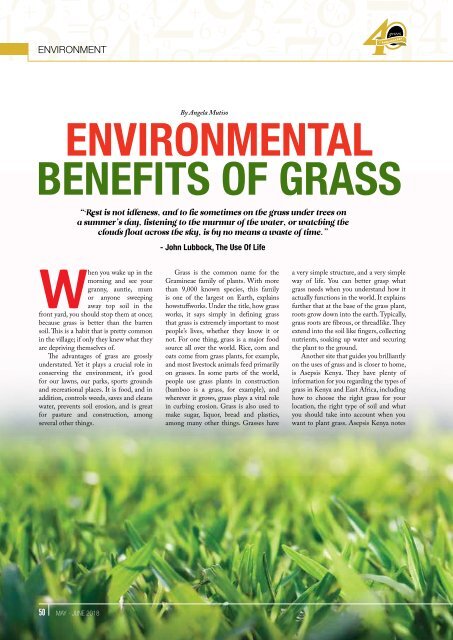May-June-issue
Create successful ePaper yourself
Turn your PDF publications into a flip-book with our unique Google optimized e-Paper software.
ENVIRONMENT<br />
By Angela Mutiso<br />
ENVIRONMENTAL<br />
BENEFITS OF GRASS<br />
“Rest is not idleness, and to lie sometimes on the grass under trees on<br />
a summer’s day, listening to the murmur of the water, or watching the<br />
clouds float across the sky, is by no means a waste of time.”<br />
- John Lubbock, The Use Of Life<br />
When you wake up in the<br />
morning and see your<br />
granny, auntie, mum<br />
or anyone sweeping<br />
away top soil in the<br />
front yard, you should stop them at once;<br />
because grass is better than the barren<br />
soil. This is a habit that is pretty common<br />
in the village; if only they knew what they<br />
are depriving themselves of.<br />
The advantages of grass are grossly<br />
understated. Yet it plays a crucial role in<br />
conserving the environment, it’s good<br />
for our lawns, our parks, sports grounds<br />
and recreational places. It is food, and in<br />
addition, controls weeds, saves and cleans<br />
water, prevents soil erosion, and is great<br />
for pasture and construction, among<br />
several other things.<br />
Grass is the common name for the<br />
Gramineae family of plants. With more<br />
than 9,000 known species, this family<br />
is one of the largest on Earth, explains<br />
howstuffworks. Under the title, how grass<br />
works, it says simply in defining grass<br />
that grass is extremely important to most<br />
people’s lives, whether they know it or<br />
not. For one thing, grass is a major food<br />
source all over the world. Rice, corn and<br />
oats come from grass plants, for example,<br />
and most livestock animals feed primarily<br />
on grasses. In some parts of the world,<br />
people use grass plants in construction<br />
(bamboo is a grass, for example), and<br />
wherever it grows, grass plays a vital role<br />
in curbing erosion. Grass is also used to<br />
make sugar, liquor, bread and plastics,<br />
among many other things. Grasses have<br />
a very simple structure, and a very simple<br />
way of life. You can better grasp what<br />
grass needs when you understand how it<br />
actually functions in the world. It explains<br />
further that at the base of the grass plant,<br />
roots grow down into the earth. Typically,<br />
grass roots are fibrous, or threadlike. They<br />
extend into the soil like fingers, collecting<br />
nutrients, soaking up water and securing<br />
the plant to the ground.<br />
Another site that guides you brilliantly<br />
on the uses of grass and is closer to home,<br />
is Asepsis Kenya. They have plenty of<br />
information for you regarding the types of<br />
grass in Kenya and East Africa, including<br />
how to choose the right grass for your<br />
location, the right type of soil and what<br />
you should take into account when you<br />
want to plant grass. Asepsis Kenya notes<br />
50 MAY - JUNE 2018

















